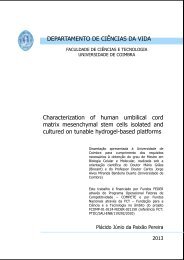role of th1 and th17 cd4+ t cell subsets in the pathogenesis of ...
role of th1 and th17 cd4+ t cell subsets in the pathogenesis of ...
role of th1 and th17 cd4+ t cell subsets in the pathogenesis of ...
You also want an ePaper? Increase the reach of your titles
YUMPU automatically turns print PDFs into web optimized ePapers that Google loves.
experimental autoimmune uveitis (EAU) animal model for autoimmune uveitis <strong>in</strong><br />
humans, Th17 <strong>cell</strong>s played a dom<strong>in</strong>ant <strong>role</strong> <strong>in</strong> <strong>the</strong> immunization model with <strong>the</strong> ret<strong>in</strong>al<br />
antigen <strong>in</strong>terphotoreceptor ret<strong>in</strong>oid‐b<strong>in</strong>d<strong>in</strong>g prote<strong>in</strong>. However, Th1 <strong>cell</strong>s were able to<br />
<strong>in</strong>duce severe EAE <strong>in</strong> a transfer model <strong>and</strong> <strong>in</strong>dependently <strong>of</strong> local IL‐17 (Luger et al.,<br />
2008) show<strong>in</strong>g that <strong>the</strong> dom<strong>in</strong>ant effector T helper <strong>cell</strong> phenotype <strong>in</strong> pathological<br />
conditions may be determ<strong>in</strong>ed by <strong>the</strong> model. Similarly, <strong>the</strong> adoptive transfer <strong>of</strong> ei<strong>the</strong>r<br />
hen egg lysozyme‐specific Th1 or Th17 <strong>cell</strong> l<strong>in</strong>eages <strong>in</strong>to hosts express<strong>in</strong>g hen egg<br />
lysozyme as pseudo autoantigen <strong>the</strong>ir eyes <strong>in</strong>duced ocular <strong>in</strong>flammation but with slight<br />
differences <strong>in</strong> histological pathology <strong>and</strong> selective cytok<strong>in</strong>e <strong>and</strong> chemok<strong>in</strong>e expression,<br />
<strong>in</strong>dicat<strong>in</strong>g that Th1 <strong>and</strong> Th17 might have dist<strong>in</strong>ct activities <strong>in</strong> mediat<strong>in</strong>g <strong>in</strong>flammation<br />
(Cox et al., 2008). More recently, <strong>in</strong> <strong>the</strong> experimental model for autoimmune diabetes,<br />
adoptive transfer <strong>of</strong> Th1 or Th17 <strong>cell</strong>s from BDC2.5 transgenic mice <strong>in</strong>to NOD/SCID<br />
recipient mice <strong>in</strong>duced diabetes with similar rates <strong>of</strong> onset. Interest<strong>in</strong>gly, a substantial<br />
plasticity <strong>of</strong> Th17 <strong>cell</strong> commitment toward a Th1‐like pr<strong>of</strong>ile was observed <strong>in</strong> <strong>the</strong><br />
NOD/SCID recipients (Bend<strong>in</strong>g et al., 2009). In fact, a recent report emphasized <strong>the</strong><br />
plasticity <strong>of</strong> Th17 <strong>cell</strong>s through <strong>the</strong> use <strong>of</strong> fluorescent reporter mice for IL‐17F by<br />
show<strong>in</strong>g that Th17 <strong>cell</strong>s convert to a Th1 phenotype when transferred <strong>in</strong>to lymphopenic<br />
hosts but not <strong>in</strong>to normal animals (Nurieva et al., 2009).<br />
In summary, <strong>in</strong> <strong>the</strong> past years we have witnessed a real revolution <strong>in</strong> <strong>the</strong> underst<strong>and</strong><strong>in</strong>g<br />
<strong>of</strong> helper T <strong>cell</strong> <strong>subsets</strong> biology <strong>and</strong> differentiation <strong>and</strong> <strong>the</strong>ir <strong>role</strong> <strong>in</strong> pathological<br />
conditions. This subject was found to be more complex than <strong>in</strong>itially thought <strong>and</strong> too<br />
haste rush was taken <strong>in</strong> <strong>the</strong> evaluation <strong>of</strong> <strong>the</strong> experimental data, lead<strong>in</strong>g to some<br />
confusion <strong>in</strong> <strong>the</strong> field.<br />
38<br />
1.5 ‐ CHEMOKINES AND CHEMOKINE RECEPTORS<br />
Chemok<strong>in</strong>es <strong>and</strong> chemok<strong>in</strong>e receptors are important <strong>cell</strong> migration regulators dur<strong>in</strong>g an<br />
immune response. Chemok<strong>in</strong>es exert <strong>the</strong>ir function via <strong>in</strong>teraction with <strong>the</strong>ir cognate<br />
receptors <strong>in</strong> <strong>the</strong> target <strong>cell</strong>, which are G prote<strong>in</strong>‐coupled receptors (GPCRs), thus<br />
activat<strong>in</strong>g multiple signal<strong>in</strong>g transduction pathways depend<strong>in</strong>g on <strong>the</strong> <strong>cell</strong> type.

















